

Daily migration of marine life to and from the twilight zone to the ocean surface.
“There is a 5th dimension beyond that which is known to man.It is the middle ground between light and shadow.It is an area, which we call, the Twilight Zone.” ~Rod Serling
Like many kids growing up in the 1960’s, I eagerly anticipated every episode of a black-and-white TV series by Rod Serling, expecting to be surprised, maybe even a little scared, of the mysteries of that 5th dimension he called “The Twilight Zone.” Little did I know that decades later as an oceanographer, I’d find myself at sea with over 60 like-minded scientists on a program specifically targeting the mysteries of another twilight zone—the one in the ocean that lies just below the sunlit surface.

The WHOI EXPORTS team showed off their glow-in-the-dark ocean twilight zone t-shirts prior to departure from Seattle in August. Credit: WHOI/Ken Buesseler
What motivates us is the need to learn more about the role of the twilight zone and the animals that live there in regulating Earth’s climate. The story of how they do this actually starts at the surface, where microscopic marine algae, or phytoplankton, turn carbon dioxide in the water into organic matter via photosynthesis, much like plants on land.
This organic matter forms the base of the marine food web, which basically means that these microscopic plants serve as food for tiny marine animals called zooplankton, which are eaten by larger marine organisms and so on up to larger animals, like the fish that humans consume. Many of these animals come up from the twilight zone at night, using the cover of darkness to feed in surface waters and then disappear come daybreak. This is, in fact, the largest animal migration on Earth and happens around the globe every day, and we barely know it happens.

Phytoplankton in the form of a diatom chain. Credit: University of Rhode Island/Stephanie Anderson
But I am getting ahead of myself, because despite how appropriate Rod Serling’s description of the mysteries of “the middle ground between light and shadow” fits with what we are doing out here, peering with our instruments into the dimly lit depths, his TV show is not the origin of the name of a twilight zone in ocean sciences. In fact, at least as far back as 1915, textbooks included discussion of the “decrease in the abundance of life from the sunlit surface layers, through the twilight zone, to the zone of darkness,” as was written in College Physiography.
Getting back to this cruise, most of the carbon either sinks out of the surface ocean directly or is carried by animals back down to the twilight zone in their guts and gets excreted. All of this sinking carbon becomes food for other twilight zone animals, with less and less remaining as you go deeper. This constant rain of organic carbon is known as “marine snow,” which drifts through the twilight zone and into the deep ocean.
Who cares how much organic matter or carbon goes through the twilight zone? Well, if you are an animal living in the twilight zone, that’s your main food supply. As a human concerned with the potential for rising carbon dioxide levels in the atmosphere to disrupt our climate, it’s the quickest way you can get organic carbon to the deep ocean, effectively removing it from contact with the surface ocean and atmosphere for hundreds or thousands of years.
Simply put, without the ocean storing carbon in the deep sea, the levels of carbon dioxide in the atmosphere would be much higher than they are today. And the last time they were this high, Earth was a much different place.

The open top of a neutral-buoyancy sediment trap (NBST) showing the opening through which marine snow drifts and is then collected. Credit: UCSB/David Siegel
WHOI marine chemist Ken Buesseler (right) helps deploy a sediment trap from the research vessel Roger Revelle as part of the EXPORTS program. Credit: UCSB/Alyson Santoro
The tools I used to measure this cascade of particles carrying organic carbon to depth on this voyage include sediment traps—something like a rain gauge that captures in a tube the sinking particles that are slowly settling through the water. A second method my group uses to measure sinking particles takes advantage of a naturally occurring element called thorium-234, which is slightly radioactive and decays with a precise 24.1-day half-life. This clock allows me to calculate very precisely how much carbon is being carried from the surface through the twilight zone.
It’s far too early to share my results from this cruise, but the importance and complexity of these links between twilight zone organisms and climate should not be underestimated. Like snowfall on land, organic carbon transport to the depths varies with the seasons and locations in the oceans, but in ways we cannot predict. And it is important for us in our efforts to better understand how quickly climate will change as we keep adding more carbon dioxide to the atmosphere. This job is so complex that it takes a village out here aboard two research ships, with autonomous vehicles in the water and support teams on land and satellites above. We work together to study these carbon flows and the living organisms in the twilight zone that create what marine biologist and conservationist Rachel Carson called the “most stupendous snowfall on earth.”
I don’t know if there are any episodes of The Twilight Zone to watch out here, but I do know there are many deeper mysteries we hope to unravel about the ocean’s twilight zone.
Ken Buesseler is a senior scientist at the Woods Hole Oceanographic Institution. He has been working for decades on the ocean twilight zone and its impact on Earth’s carbon cycle. He is currently on the R/V Roger Revelle as part of the Export Processes in the Ocean from Remote Sensing (EXPORTS) field campaign.
This piece was originally published on the NASA Earth Expeditions blog.
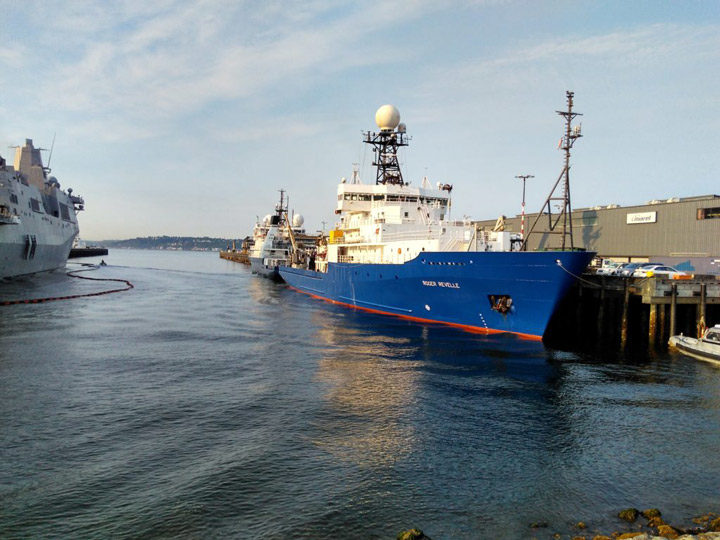
The R/V Roger Revelle (front) and the R/V Sally Ride (back) mobilizing for the EXPORTS field campaign at Pier 91 in Seattle. Credits: University of Rhode Island/Menden-Deuer Lab.
Anna Ward is a marine biology undergraduate at the University of California, San Diego within the Scripps Institution of Oceanography. This summer she is working with Dr. Susanne Menden-Deuer (advisor) and Dr. Gayantonia Franze (mentor) at the University of Rhode Island, Graduate School of Oceanography. She intends to pursue a career in oceanography, and has particular interest in microzooplankton motility and understanding how planktonic organisms respond to changes in surrounding environmental conditions. She is also passionate about furthering science communication through nontraditional media platforms and promoting environmental conservation through education.
..some advice for anyone preparing for a research cruise: be flexible, be prepared (well, the best that you can be), and be excited.
“Hey Anna, want to help me make something?” asked Dr. Heather McNair of me one day. I was instantly intrigued. What were we going to make? What was it going to be used for? How were we going to put it all together? So many questions were running through my head, but I was ready to explore and learn.
This summer, I have been working in Dr. Susanne Menden-Deuer’s lab at the University of Rhode Island’s Graduate School of Oceanography as part of an National Science Foundation-funded Research Experiences for Undergraduates program called Summer Undergraduate Research Fellowship in Oceanography (SURFO). My primary focus was to understand how environmental factors, such as turbulence, affect the way microscopic marine organisms graze on other organisms. While my primary research kept me busy, I wanted to explore other areas of oceanographic research, so I offered to help in the lab any way I could.

Undergraduate Research Fellow Anna Ward measuring plankton abundances in the laboratory. Credits: University of Rhode Island/Menden-Deuer Lab
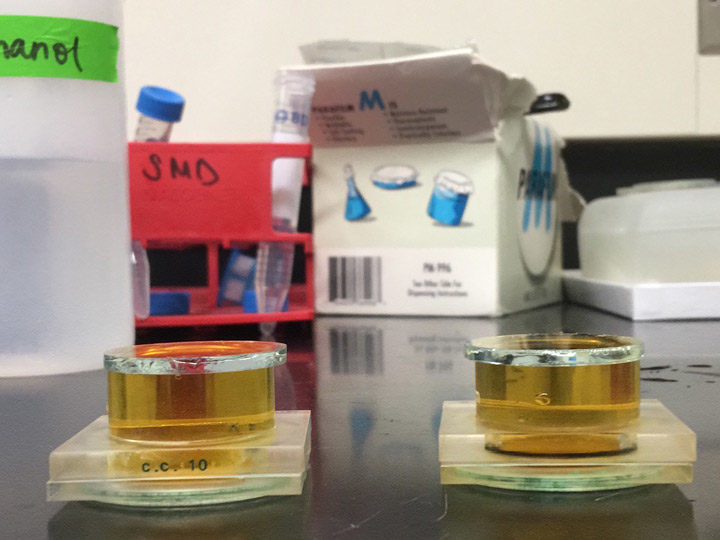
Preserved microzooplankton samples settle for microscopy analysis. Credits: University of Rhode Island/Menden-Deuer Lab
Dr. Heather McNair, a postdoctoral fellow in the Menden-Deuer Lab, explained that she was preparing for a research cruise as part of the Export Processes in the Ocean from Remote Sensing, or EXPORTS, field campaign and wanted help making a positive pressure pump, a device used to automate water sampling. I had never even heard of a positive pressure pump before, and now I was supposed to make one?! Enthusiastic and eager to begin, I put my thinking skills to the test. She showed me some of the physical pieces and explained how we wanted our end product to function and look. Okay, sounded pretty self-explanatory, put a few pieces together, and finished product—done.
Except one thing: We did not have all of the pieces, and we needed to create this device using only items available in the lab. Similar to being out at sea, you cannot simply go to the store and get what you need; you have to figure out a way to make it work given the resources available. After a lot of trial and error, we created a device that would work well at sea. Mission accomplished.

Postdoctoral Fellows Dr. Heather McNair (left), Dr. Francoise Morison (middle), and Dr. Ewelina Rubin mobilizing the R/V Roger Revelle for EXPORTS. Credits: University of Rhode Island/Menden-Deuer Lab
Unforeseen and challenging obstacles such as this are common at sea. While it might seem simple, there are many fine details involved in preparing for a cruise. Think about the average science classroom: there are various instruments and glassware, as well as other fundamental components such as water sources, sinks, safety equipment, and more. You have to think about where all of these items will go on the ship, how to secure them for the natural movements of the ship at sea, etc.
Some things are simpler, such as determining how many bottles you need for an experiment, while others are more complex, like transporting a large, expensive instrument across the country that will undergo constant motion and likely rough, stormy seas. While this process is stressful for some, it is truly one of my favorite parts of a research cruise.
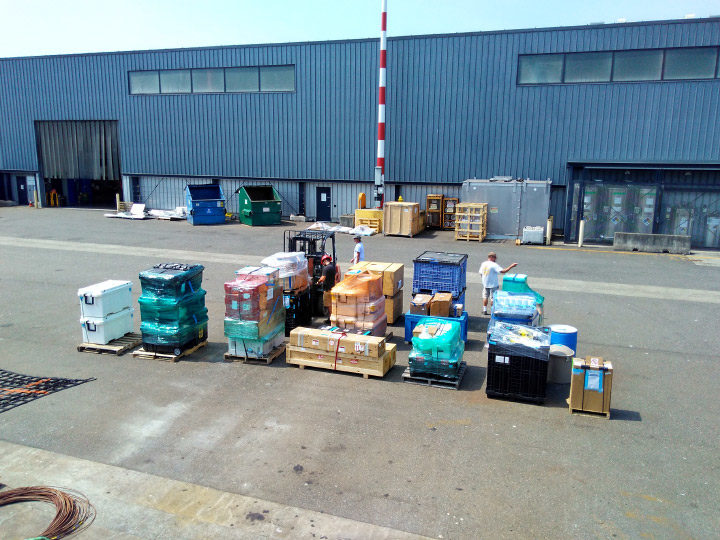
Scientific equipment on the dock waiting to be loaded onto the research vessels. Credits: University of Rhode Island/Menden-Deuer Lab
No matter how prepared scientists are, unexpected things always happen at sea, including 12-foot swells sloshing up against the side of the boat. That might not seem like much for an avid surfer, but for research vessels these waves can be felt instantaneously by members. I remember my last research cruise, when we hit a wave a bit larger than I expected. I was performing an experiment and zoom, all of the bottles starting sliding across the table. Here I was trying to catch them while holding my stance. In times like these, I truly appreciated that the tables were screwed into the walls, and the boxes under tables were held in place with ratchet straps.
Wet-lab setup on a prior research cruise containing filtration systems tied down to the tables and carboys and boxes bungeed to the ship for safety during transport. Credits: University of Rhode Island/Menden-Deuer Lab
There are so many components to think about before going to sea in addition to the simple things, like remembering to bring a toothbrush and an extra changes of clothes. Staying organized is key. I cannot imagine trying to pack all of our equipment without the handy packing list we prepared.
But more importantly, some advice for anyone preparing for a research cruise: be flexible, be prepared (well, the best that you can be), and be excited. The thrill and excitement from performing research on a ship is extraordinary, something to truly embrace. Even if those long days and nights packing seem never-ending, just remember it will be worth it and one of the most incredible learning experiences of your life. To everyone aboard the EXPORTS cruise, fair winds and following seas. The packing is done and now you have made it to the best part—researching at sea.
The port in Seattle, Washington, from which the R/V Roger Revelle and the R/V Sally Ride embarked for the northeastern Pacific Ocean. Credits: University of Rhode Island/Menden-Deuer Lab
This piece was originally published on the NASA Earth Expeditions blog.

A mixed phytoplankton community. Credit: University of Rhode Island/Stephanie Anderson
I am Dave Siegel, a professor of marine science at the University of California, Santa Barbara. I have been working for many years to implement the Export Processes in the Ocean from Remote Sensing (EXPORTS) oceanographic campaign: a coordinated field effort to understand the interactions between life in the sea and Earth’s carbon cycle.
Last Thursday night, I watched “my baby” of a campaign sail away, as the Research Vessel Sally Ride left Pier 91 in Seattle for the northeastern Pacific Ocean.
While I am the science lead for EXPORTS, it’s not just my baby—it is truly a group effort. Two teams of scientists created the EXPORTS science and implementation plans, with a lot of input from the greater oceanographic community. The result is a campaign comprising more than 50 funded NASA and NSF investigators from nearly 30 institutions and many graduate students, postdocs and technicians, all excellently supported by the masters and crews of two Scripps Institution of Oceanography’s research vessels: the R/V Roger Revelle and the R/V Sally Ride.

The R/V Sally Ride, operated by the Scripps Institution of Oceanography, anchored at Pier 91 in Seattle before departing for the northeastern Pacific Ocean on Thursday, Aug. 9. Credit: NASA/Katy Mersmann
EXPORTS aims to develop a predictive understanding of the interactions of life in the sea and Earth’s carbon cycle, which is critical for quantifying the carbon storage capacity of the global ocean. The oceans are Earth’s largest active reservoir, or storage, of carbon and carbon dioxide concentrations in the atmosphere and thus helps regulate our planet’s climate. This predictive understanding of the interactions of ocean life and the carbon cycle is especially important as we are seeing that our ocean ecosystems are changing in response to changes in Earth’s physical climate. To do this we need data to test and validate these satellite-based assessments and numerical model predictions.
We are trying to tackle a super hard problem—one I believe to be a true grand challenge in Earth System Science. Our approach is simply to follow the money. For ocean ecosystems, that currency is the energy stored in phytoplankton carbon from photosynthesis. The production of phytoplankton carbon is nearly balanced by its consumption by animals called zooplankton, which in turn provide the energy for the higher trophic levels of the sea, such as fisheries and charismatic megafauna (whales, seals, sharks, and the like).
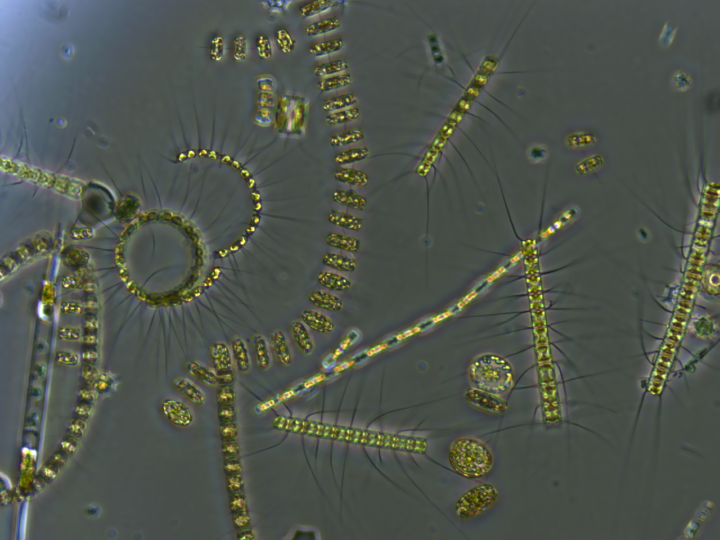
A mixed phytoplankton community. Credit: University of Rhode Island/Stephanie Anderson
The slight imbalance—roughly 10 percent of phytoplankton production globally—drives an export of organic carbon from the well-lit surface ocean into the dimly-lit twilight zone beneath. Within the twilight zone, microbes and animals of all description consume this exported organic carbon, utilizing their energy for metabolism. This export of organic carbon from the upper ocean and their consumption within the twilight zone, along with ocean circulation, shape the carbon storage capacity of the global ocean and frame the two major research questions for EXPORTS.
Constructing a field campaign to identify and quantify the flows of organic carbon through the ocean is, of course, a major challenge. Phytoplankton physiologists need to assess phytoplankton growth rates and responses to perturbations in their required nutrients (nitrogen, phosphate, silica & iron). Zooplankton grazing and the carbon cycle impacts of their daily vertical migration to the sunlit layer of the ocean from the twilight zone need to be assessed.
In the hydro lab aboard the R/V Roger Revelle, sampling tubes will collect water samples at varying ocean depths for analysis. Credit: NASA/Katy Mersmann
Sediment traps that catch the rain of sinking particles measure the flux of sinking carbon as well as make detailed geochemical measurements that test how well our measurements of the individual pathways reflect the large-scale mass budgets needed to build and test satellite and computational models. Optical oceanographers make ocean color measurements that link the EXPORTS datasets to NASA satellite data products. And I feel bad that I left out so many other individual research activities going on, but mentioning each of them would take up another two paragraphs!
For EXPORTS, scientists are deploying robotic explorers, like these from the Applied Physics Lab at the University of Washington. They are traveling with the ships, taking measurements at various depths. Credit: NASA/Michael Starobin
The measurements needed to constrain the various food web and export pathways as well as adequately sample the highly variable ocean environment requires technologists that can overcome these challenges. For example, the EXPORTS team includes robotics experts who build, deploy, and analyze data from an array of autonomous underwater vehicles (AUV) that sample ocean properties on time scales ranging from minute to years.
EXPORTS has also taken advantage of recent technological advances such as novel high-throughput microscopes and in situ imaging devices that take individual images of billions of phytoplankton cells as well as zooplankton and other various organic matter. These images are then analyzed using advanced machine learning techniques to provide unique views of the structure of plankton communities.
Advancements are also available from the biomolecular sciences where metagenomic and bioinformatics approaches provide complementary ways to characterize plankton communities and their metabolism. Lastly, several projects include numerical modelers who will use computational approaches to help answer EXPORTS science questions.
The first EXPORTS field deployment will be to Station P (50N 145W) in the Northeast Subarctic Pacific Ocean. Station P (or PAPA) has been sampled and resampled over many decades—from as far back as 1949, when it served as an ocean weather station. Presently, Station P is the terminus of the Canadian Line P transect ocean research program and is an area of focus for the National Science Foundation’s Ocean Observatories Initiative project.
Last week, the R/V Roger Revelle and the R/V Sally Ride sailed to Station P. Both are floating laboratories that enable our research, but they will have different missions. The R/V Roger Revelle will make detailed rate measurements and conduct a wide variety of experiments while the R/V Sally Ridewill make spatial surveys around its partner ship to assess the three-dimensionality of these processes. These ship-based measurements will be supplemented by the array of AUVs. Both ships and robots will make ocean optical measurements linking the EXPORTS field data to present and future NASA ocean color satellite missions.
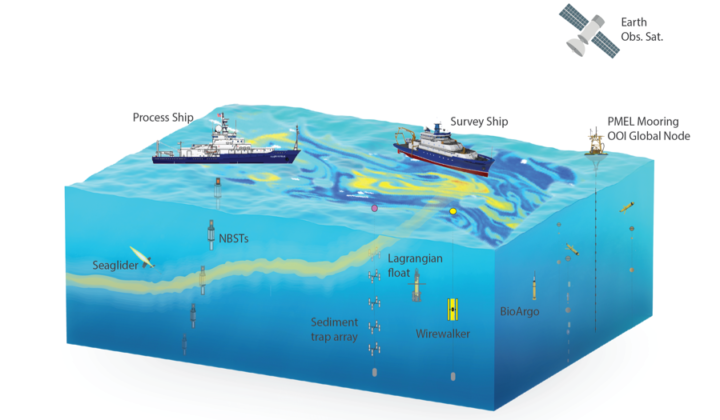
Graphic representation of the Northeastern Pacific Ocean deployment for EXPORTS.
EXPORTS is also planning a second field deployment in the North Atlantic Ocean in the spring of 2020 to provide contrasting data. Furthermore, NASA has supported a group of Pre-EXPORTS projects aimed at mining available, relevant data sources for use in EXPORTS synthesis analyses and to conduct modeling experiments to help plan this and the North Atlantic expeditions.
So I’m the science lead but I’m not sailing. Seems weird, but early in our planning we were worried about the coordination between all of the things going on. My job back home now is to help coordinate activities on the two ships and assist the four co-chief scientists in fouling off whatever curveballs that may come. I’m sure they will provide blog posts soon introducing themselves.
It is been a long time coming and I realized that as the R/V Sally Ride was sailing away. I have been there from the start pushing this along, so I suppose it is “my baby.” I do want to thank all involved in the planning and implementation, including the program officers at NASA and NSF.
Further information about EXPORTS can be found at the NASA EXPORTS expedition team blog and the EXPORTS website.
This piece was originally published on the NASA Earth Expeditions blog.